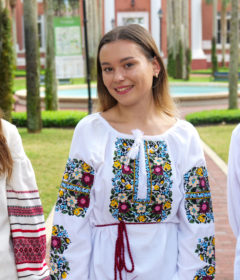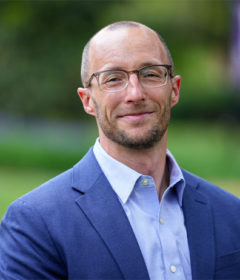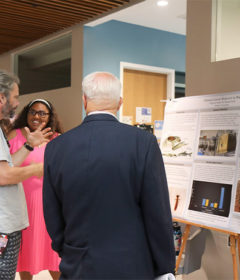Students Shine in Solar Array
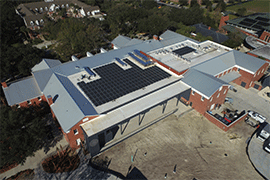
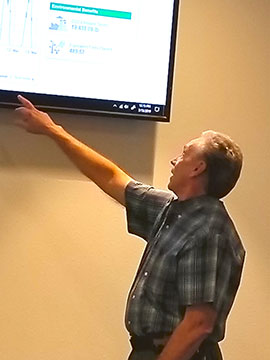
So, students: What is your $5 per semester paying for as part of Stetson’s Revolving Green Fund?
You can find the answer atop the CUB — plus see the results on three video screens in the CUB, where daily outputs of new solar panels are visible. Two screens are located in the Commons dining room; a third sits just outside the Bookstore. In addition, real-time output details for power and energy can be monitored via an online portal, SolarEdge.
Stetson’s (and your) approximately $170,000 solar photovoltaic project — the university’s largest-ever such initiative, officially called the CUB Dining Room Flat Roof Rooftop — is alive and thriving.
A total of 231 solar panels are producing a projected annual output of 143 MWh, with a corresponding estimated annual metered cost avoidance of nearly $10,000. An annual value of 131.2 MWh originally had been estimated but was upgraded following initial testing, meaning an even greater return on investment.
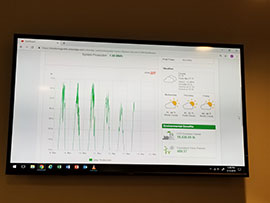
Currently, the solar panels generate roughly 12 percent of the CUB’s required electricity, with the panels effectively in operation from sunup to sundown or slightly longer.
Environmental sustainability in action.
All was on display and explained at noontime March 13 during a special “reveal” at Lee’s Garage in the CUB. Stetson students, faculty, administrators and staff were in attendance.
“This is the first of many great things to come,” commented Wendy Anderson, Ph.D., professor and chair of Environmental Science and Studies, before the meeting. “… We are going to do more big projects. The students, just like on this project, will continue to have the first voice in coming up with ideas. This is their money, and this is their opportunity to lead.”
“We are very thankful everyone had the patience and tenacity to work with each other and to learn how to do this, and to do it right,” said Stetson President Wendy B. Libby, Ph.D., during the meeting. “I just think it’s a demonstration project. This is tremendous.”
The project marks the culmination of an ambitious effort by students, called Stetson’s Revolving Green Fund.
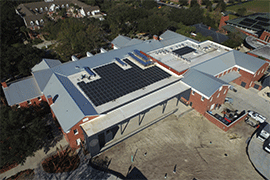
In 2014, Stetson’s first-ever Environmental Fellow, Sarah Coffey ’18, raised the idea of a green fund on campus to Stetson Professor Tony Abbott, Ph.D., who had helped to establish the Environmental Fellows’ program. A year later, Nate Bodger ’19, another Environmental Fellow, figured that with university funding generally tight, “maybe students would want to chip in.” He created the initial proposal and presented it to the Environmental Working Group, composed of students, faculty and staff, which he now chairs.
In May 2017, following lengthy groundwork by students and administrators — including surveys, various approvals and final determinations — Stetson established the green fund, with all students paying a $5 fee each semester to fund environmental projects.
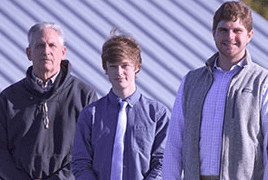
In November 2017, students were asked to submit ideas for projects that would save the university money and decrease environmental impact. Nearly 200 suggestions were received, and the clear winner was solar, conceived on the idea of efficiently generating electricity. Ultimately, the CUB location was chosen as the solar site by virtue of both cost-effectiveness and visibility. A nearby off-campus site also was seriously considered. The CUB has been a campus focal point since its original construction in 1957, with that site also putting the solar project “right above the students’ heads rather than off campus,” as described by Jimmy Dean ’20, one of the students who helped steer the project last spring.
That’s when staffers such as John Wimer, manager of Energy Conservation and Technical Support at Stetson, officially entered into the picture. Wimer was charged with helping to make the technical aspects of the project click. Notably, the 38-year veteran of Stetson also learned a bit, citing that his “learning was steep, but it wasn’t very long.”
He added: “It was such an interested project.”
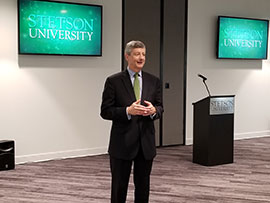
The convergence of administrators, students, faculty and staff, among others, represents a continual march through strategic mapping that began in 2014 by the university, according to Bob Huth, Stetson’s executive vice president and chief financial officer. More than just a solar project, Huth said, it’s “part of an orchestrated effort” that follows in line with the university’s strategic map (2014-2019), with the overarching goal to “establish Stetson as a university of choice for innovative approaches to tackling complex challenges,” which was approved by Stetson University’s Board of Trustees.
Finally, in terms of funding, the Revolving Green Fund (students) paid $60,000, while the Student Government Association and the university each paid $30,000. The remainder of the funding came from a university loan to be repaid by the metered cost avoidance (estimated at almost $10,000 a year). After the loan is repaid, those cost-avoidance dollars will be deposited back into green fund. If the solar array produces more energy than anticipated, the loan can be paid off earlier, and a greater amount of money will go into the green fund, Huth explained.
“We’re in a much better position for the future than we’ve been in the past,” noted Al Allen, Stetson’s associate vice president for Facilities Management.
So, students, that’s what you’re paying for — in other words, excellent work.
-Michael Candelaria

